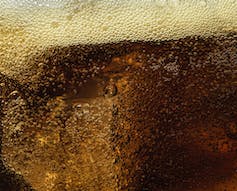Many people love the refreshing effervescence of a soda, champagne, beer or sparkling water. When you take a sip, the gas bubbles in the beverage burst, and the released gas tickles your nose. But have you ever wondered how carbonation actually works?
I’m a professor who teaches classes in chemistry and fermentation and a carbonated beverage enthusiast and home brewer myself. While the basic process of carbonation is relatively simple, a variety of factors – from temperature to surface tension – can affect the taste and quality of beverages.
Dissolving carbon dioxide
Carbonation involves dissolving the colorless and odorless carbon dioxide – CO₂ – gas into a liquid. When carbon dioxide is added to a sealed bottle or can containing water, the pressure in the bottle or can increases, and the carbon dioxide dissolves into the liquid.
The CO₂ above the liquid and the CO₂ dissolved in the liquid reach chemical equilibrium. Chemical equilibrium essentially means the rate that CO₂ dissolves into the liquid is equal to the rate that CO₂ is released from the liquid. It’s based on the amounts of CO₂ both in the air and in the liquid.
Some of the dissolved CO₂ reacts with the water to form carbonic acid, which has a chemical formula of H₂CO₃. So once some of the dissolved CO₂ converts to H₂CO₃, more CO₂ from the air above can dissolve into the liquid and reestablish chemical equilibrium.
Carbonation happens when CO₂ is forced into a can or bottle, where it dissolves into the liquid.
When you open a bottle or can, the pressure above the carbonated liquid drops to match the pressure outside of the bottle or can. The pressure release results in a hissing sound, and you see bubbles rising in the liquid as the H₂CO₃ converts back to CO₂ and that gas escapes to the surface. The carbonic acid in the beverage is what makes it taste a little sour.
A colder drink is a bubblier one

The bubbles in carbonated beverages are filled with CO₂ gas moving from an area of high CO₂ concentration to an area of low CO₂ concentration.
Jonathan Knowles/DigitalVision via Getty Images
Another important factor influencing carbonation is temperature. Most gases, including carbon dioxide, do not dissolve well in liquids as the temperature of the liquid rises. That’s why carbonated drinks go flat if you leave them out at room temperature.
Conversely, if you place your favorite carbonated beverage in the refrigerator and allow it to get cold, more dissolved carbon dioxide will stay in the beverage while it’s still sealed. When you open the chilled bottle or can, the liquid is more bubbly because there was more dissolved carbon dioxide in the cold beverage.



